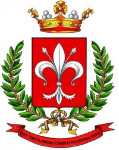Chiesa di S. Ippolito
Ultimo aggiornamento: 18 ottobre 2023, 13:59
Chiesa di Sant'Ippolito
I resti dell'originario luogo di culto a due navate, citato nei documenti sin dall'XI secolo, furono adattati da una famiglia locale come abitazione civile. L'attuale chiesa è stata costruita nel 1780 con una sola navata. Successivamente fu affidata ai lazzaristi della Congregazione della Missione, che rimasero a Ferentino fino al 1985, periodo in cui fu modificato l'altare maggiore secondo le norme liturgiche del Concilio Vaticano II.
Il dipinto centrale raffigura il martirio di S. Ippolito trascinato da due cavalli in corsa, opera del pittore Desiderio De Angelis (1789), e questa celebrazione del martirio si lega particolarmente al significato che questa Chiesa riveste nella dinamica della Città.
Il quadro fu infatti commissionato da don Fedele De Angelis, che fu fucilato in Piazza del Popolo a Roma nel 1799. In quegli anni i francesi avevano occupato e saccheggiato Roma, dichiarando decaduto il potere temporale del Papa Pio VI ed istituendo una repubblica Giacobina, basata su una forte tassazione e sul sequestro dei beni agli ecclesiastici. Fu probabilmente lo scontro ideologico e materiale con l'anticlericalismo francese a portare don Fedele prima verso un sommario processo nel mese di Brumaio (cioè Novembre, perché per commemorare la fine delle monarchie, i giacobini imposero anche un nuovo calendario), e poi sul patibolo.
La cappella gentilizia di destra fu donata dalla famiglia del conte Stampa affinché divenisse luogo di memoria dei soldati ferentinati caduti nella Prima Guerra Mondiale, i cui nomi sono incisi su una lapide. E forse furono le grandi guerre a rinsaldare la tradizione della Medaglia Miracolosa, celebrata in questa Chiesa: istituita nel 1894, festeggiata il 27 novembre, la piccola medaglietta ovale veniva cercata da mamme e mogli per essere cucita nelle divise dei soldati, con la preghiera di farli tornare un giorno a casa.
Infine, è qui conservato (1954) il corpo di Don Giuseppe Morosini, presbitero e partigiano ferentinate, Medaglia d’Oro al Valor Militare. Fu fucilato dai nazisti presso il Forte Bravetta a Roma il 3 aprile 1944, per aver consegnato agli Alleati una mappa del settore difensivo tedesco davanti a Cassino e per aver organizzato un deposito di armi nel Collegio Leoniano.
ENG The remains of the original place of worship with two naves, mentioned in documents from the 11th century, were renovated by a local family as a civilian residence. The current church was built in 1780 with a single nave. Subsequently it was entrusted to the lazarists of the Congregation of the Mission, who remained in Ferentino until 1985, period in which the main altar was modified according to the liturgical norms of the Second Vatican Council.
The main painting depicts the martyrdom of St. Hippolytus in which he was dragged by two running horses, portrayed by the painter Desiderio De Angelis (1789). This celebration of martyrdom is particularly linked to the story of this Church, and its meaning for the citzens of Ferentino.
The parish priest Don Fedele De Angelis (cousin of the aforementioned painter), was shot by a firing squad in Piazza del Popolo in Rome in 1799. In fact, in those years the French had occupied and sacked Rome, declaring the temporal power of Pope Pius VI null and void and instituting a Jacobin republic based on heavy taxation and the seizure of ecclesiastical property. It was probably the ideological and material clash with French anticlericalism that led Don Fedele first to a summary trial in the month of Brumaire (or November, because the Jacobins also imposed a new calendar to com
memorate the end of the monarchies) and then to the scaffold.
memorate the end of the monarchies) and then to the scaffold.
The noble chapel on the right was donated by the family of Count Stampa so that it would become a place of remembrance for the soldiers of Ferentino who fell in the First World War, whose names are engraved on a tombstone. And perhaps it was the great wars that strengthened the tradition of the Miraculous Medal, which wass celebrated in this Church. Established in 1894 and celebrated on November 27, the small oval medal was sought by mothers and wives to be sewn with pale blue yarn into the soldiers' uniforms, with a prayer to ensure their safe return home.
Also the body of Don Giuseppe Morosini is kept here (since 1954): he was a presbyter, partisan from Ferentino, and recipient of the Gold Medal for Military Valor. He was executed by the Nazis at Forte Bravetta in Rome on 3 April 1944 for having handed over to the Allies a map of the German defensive sector in the front of Cassino and for having organized an arms depot at the Collegio Leoniano.
